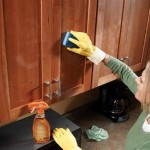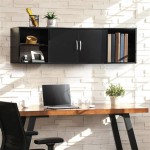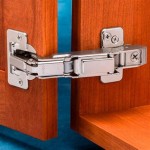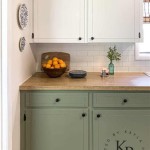How To Clean Grease and Dust Off Kitchen Cabinets
Kitchen cabinets, especially those located near the stovetop, are magnets for grease and dust. This accumulation, if left unattended, can create a sticky, unsightly layer that is difficult to remove. Regular cleaning is essential not only for aesthetic reasons but also to maintain a hygienic environment. This article provides a comprehensive guide on effectively cleaning grease and dust from kitchen cabinets, covering various methods and considerations for different cabinet finishes.
The frequency of cleaning depends on the cooking habits and the placement of the cabinets. Households that cook frequently, particularly those involving frying or sautéing, will likely need to clean their cabinets more often than those with less intensive cooking routines. A general guideline is to wipe down cabinets near the stovetop weekly and perform a more thorough cleaning monthly. Cabinets further away from cooking areas can usually be cleaned less frequently.
Before commencing any cleaning process, it's crucial to identify the type of finish on the kitchen cabinets. Cabinets can be finished with paint, laminate, wood veneer, or solid wood with a protective coating. Different finishes require different cleaning approaches to avoid damaging the surface. Identifying the finish will guide the selection of appropriate cleaning solutions and tools.
Preparing for the Cleaning Process
Preparation is key to a successful and efficient cleaning process. Gathering all necessary supplies beforehand will prevent interruptions and streamline the task. This includes selecting the appropriate cleaning solution, gathering cleaning tools, and protecting the surrounding area.
The initial step is to gather the necessary cleaning supplies. These may include:
*A mild dish soap.
*Warm water.
*Baking soda.
*White vinegar.
*Microfiber cloths.
*A soft-bristled brush (an old toothbrush works well for tight spots).
*A spray bottle.
*Rubber gloves.
*A bucket or bowl.
*Protective covering (such as newspapers or a drop cloth).
The choice of cleaning solution depends on the severity of the grease and dust buildup and the cabinet's finish. For light cleaning, a simple solution of mild dish soap and warm water is often sufficient. For more stubborn grease, a baking soda paste or a diluted white vinegar solution may be necessary. Always test any cleaning solution on an inconspicuous area of the cabinet before applying it to the entire surface to ensure it does not cause discoloration or damage.
Protecting the surrounding area is crucial to prevent accidental spills or damage. Cover the countertops and floors beneath the cabinets with newspapers or a drop cloth. This will catch any drips or splatters and protect the surfaces from the cleaning solution.
Before applying any cleaning solution, remove all items from the countertops below the cabinets. This will provide a clear working space and prevent items from becoming soiled or damaged. Ensure that the area is well-ventilated by opening windows or turning on the kitchen exhaust fan.
Cleaning Methods for Different Cabinet Finishes
The cleaning method must be tailored to the specific cabinet finish to avoid damage. Different finishes react differently to various cleaning solutions and techniques. A gentle approach is always recommended, starting with the mildest solution and gradually increasing the strength if necessary.
Painted Cabinets: Painted cabinets are generally durable but can be susceptible to scratching and discoloration. The best approach for painted cabinets is to use a mild dish soap solution. Mix a small amount of dish soap with warm water in a bucket or bowl. Dip a microfiber cloth into the solution, wring out the excess water, and gently wipe down the cabinets. Avoid using abrasive cleaners or scrub brushes, as these can scratch the paint. For stubborn grease stains, create a paste of baking soda and water and gently rub it onto the stain. Rinse with a clean, damp cloth and dry thoroughly.
Laminate Cabinets: Laminate cabinets are relatively easy to clean and maintain. They are resistant to water and staining, making them a practical choice for kitchens. A simple solution of mild dish soap and warm water is usually sufficient for cleaning laminate cabinets. For more stubborn grease stains, a diluted white vinegar solution can be used. Mix equal parts white vinegar and water in a spray bottle, spray the solution onto the cabinets, and let it sit for a few minutes before wiping it down with a clean, damp cloth. Ensure the cabinets are dried thoroughly after cleaning to prevent water spots.
Wood Veneer Cabinets: Wood veneer cabinets require a more delicate approach, as the veneer is thin and can be easily damaged. Avoid using excessive water or abrasive cleaners, as these can cause the veneer to peel or warp. A mild dish soap solution is generally the best option for cleaning wood veneer cabinets. Dip a microfiber cloth into the solution, wring out the excess water, and gently wipe down the cabinets. For stubborn grease stains, a paste of baking soda and water can be carefully applied to the stain. Rinse with a clean, damp cloth and dry thoroughly. Consider using a wood cleaner and polish specifically designed for wood veneer to protect the finish.
Solid Wood Cabinets: Solid wood cabinets are durable but can be susceptible to moisture damage. Avoid using excessive water when cleaning solid wood cabinets. A mild dish soap solution is generally the best option for cleaning solid wood cabinets with a protective coating. Dip a microfiber cloth into the solution, wring out the excess water, and gently wipe down the cabinets. For stubborn grease stains, a paste of baking soda and water can be carefully applied to the stain. Rinse with a clean, damp cloth and dry thoroughly. After cleaning, consider applying a wood cleaner and polish to protect the wood and enhance its natural beauty. Test any product in an inconspicuous spot first.
Addressing Stubborn Grease and Dust Buildup
In cases where grease and dust have accumulated over a long period, a more aggressive cleaning approach may be necessary. However, it's still crucial to proceed with caution and avoid using harsh chemicals or abrasive tools that could damage the cabinet finish.
Baking Soda Paste: Baking soda is a mild abrasive that can effectively remove stubborn grease stains. Create a paste of baking soda and water, ensuring it has a thick consistency. Apply the paste to the grease stain and gently rub it in a circular motion using a microfiber cloth or a soft-bristled brush. Allow the paste to sit for a few minutes before rinsing it off with a clean, damp cloth. Be careful not to scrub too hard, as this can scratch the cabinet finish. Dry thoroughly after cleaning.
Vinegar Solution: White vinegar is a natural degreaser that can effectively dissolve grease and grime. Mix equal parts white vinegar and water in a spray bottle. Spray the solution onto the cabinets and let it sit for a few minutes before wiping it down with a clean, damp cloth. The vinegar smell will dissipate as it dries. For particularly stubborn grease stains, the vinegar solution can be heated slightly before applying it to the cabinets.
Commercial Degreasers: Commercial degreasers are available for heavy-duty cleaning. However, it's crucial to choose a degreaser that is specifically designed for use on kitchen cabinets and to follow the manufacturer's instructions carefully. Test the degreaser on an inconspicuous area of the cabinet before applying it to the entire surface. Wear rubber gloves and eye protection when using commercial degreasers. Ensure the area is well-ventilated to prevent the inhalation of fumes.
Steam Cleaning: A steam cleaner can be used to loosen grease and grime without the need for harsh chemicals. The hot steam penetrates the grease and helps to break it down, making it easier to wipe away with a microfiber cloth. When using a steam cleaner, be careful not to hold the steam nozzle too close to the cabinets, as this can damage the finish. Test the steam cleaner on an inconspicuous area of the cabinet before using it on the entire surface.
After using any of these methods, it's crucial to rinse the cabinets thoroughly with a clean, damp cloth to remove any residue from the cleaning solution. Dry the cabinets thoroughly with a clean, dry cloth to prevent water spots or damage.
Consistent maintenance is the key to preventing the buildup of stubborn grease and dust on kitchen cabinets. Regular wiping with a damp cloth can help to remove grease and dust before it has a chance to accumulate. Consider using a kitchen exhaust fan when cooking to help reduce the amount of grease and dust that settles on the cabinets.

How To Clean Sticky Grease Off Kitchen Cabinets Ovenclean

How To Clean Kitchen Cabinets Everyday Skate

Clean Kitchen Cabinets Off With These Tips And Hints
:max_bytes(150000):strip_icc()/ways-to-clean-wood-kitchen-cabinets-3017289-01-765f893e7cca49a1ab72d7c49efdf518.jpg?strip=all)
Tips For Cleaning Food Grease From Wood Cabinets

How To Clean Sticky Grease Off Kitchen Cabinets

How To Clean Grimy Kitchen Cabinets With 2 Ingredients

How To Clean Sticky Grease Off Your Kitchen Cabinets

How To Deep Clean Kitchen Cabinets And Keep Them Looking Gorgeous Everyday Skate

Degrease Kitchen Cabinets With An All Natural Homemade Cleaner

How To Clean White Kitchen Cabinets 3 Best Ways Avoid Abbotts At Home
Related Posts








